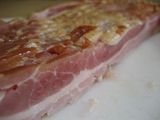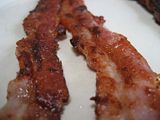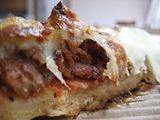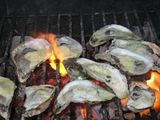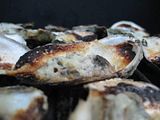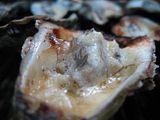Curing is the addition of salt, or, in my case, salt, sodium nitrite and sodium nitrate to aid in preserving meat by inhibiting bacterial growth. Curing also draws moisture out of meat and allows it to retain an attractive pink colour when finished. The curing of meat has been practiced for centuries, salting and smoking has been used to preserve meat since Ancient Greece.....
Why haven't I tried it? If the Ancient Greeks could to it, what's stopped me? Fear of the unknown....
Over the last year I've compiled curing agents and all the ingredients I'd need to make bacon, I was hesitant to splurge on a pork belly and fail.... But, Chris you say, remember the Ancient Greeks?
Well, today I threw caution to the wind and went for it. I picked up a 13 pound belly, sliced it into three and got to curing..... Each of my belly portions are around three and a half pounds after trimming some bone and scrappy bits off.
Belly #1
Is getting a brown sugar cure from the Sausage Maker located in Buffalo New York.
Belly #2
Is getting a maple cure, again, from the Sausage Maker in Buffalo.
Belly #3
Is getting a cure of Morton's Tender Quick and honey.
What has worried me has been the ratio of curing agent to the amount of meat. Using Tender Quick, the package says to use a tablespoon per pound of meat, easy enough. With the packaged Sausage Maker cures I was informed to "Thoroughly rub the dry cure into the bacon." Ummm ok, again I used about a Tablespoon per pound, maybe a tiny bit more, we'll see how it turns out.
I decided to keep my recipe simple, I'd love to make a paprika or peppered bacon, but, I figured I'd better keep it simple to begin with. If these turn out well, I am going to be in trouble....
Update Day 6
Almost immediately the cures drew out quite a bit of liquid from the bellies. I massaged the packages and turned them over once every day to ensure that the curing liquid was evenly distributed in the Zip Lock bags. I had a minor incident part way through the curing of the brown sugar bacon. For some reason the seal on the bag leaked and let some of the cure out. Luckily it was the thinnest and still had some liquid in the bag. After 6 days in the cure I decided to prepare the bellies which had all firmed up nicely.
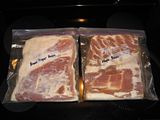
I rinsed the bellies well under running water and dried them off with paper towels and let them sit for half an hour while the smoker warmed up. I placed them on my Traeger Lil Tex smoker set on the "Smoke" setting which should run between 180°F and 200°F, but, with my luck a heat wave began today. The outside temperature was 28°C (82°F) at 9am when I started smoking the bellies and the cooker ran at 230°F most of the time.
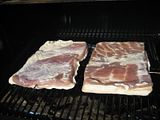
They took just over an hour and a half to reach 130°F internally (I am not eating the bacon right from the smoker, I am going to fry it first). If I was going to sample pieces straight from the smoker I'd take the internal temperature to 150°F to make sure it was cooked through.
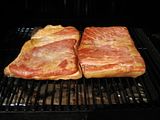
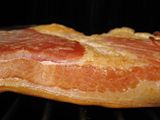
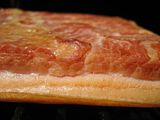
The bellies did develop some nice colour, they would have been darker if the cooker had run a little cooler. I cut off the rind when I took the bacon from the cooker and let them cool. They are now in the fridge getting ready for BLTs for dinner.
I didn't want to overload the Traeger so I did the Sausage Maker bellies first and when they were finished I did the Tender Quick/honey belly. The outside temperature was 33°C (91°F) when I put the last belly on the smoker. The Traeger was in the shade and ran a bit cooler than in the morning, varying from 195°F to 230°F. The pellicle seems a bit thicker than the pre-made cures and the didn't darken as much as the maple and brown sugar cured bellies. We'll see what the taste is like when I fry some up.... All in all, it was a very simple project, to this point I don't know why it appeared so daunting...
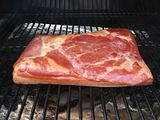
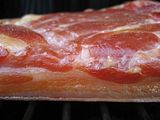
The results? Very good bacon. The Sausage Maker cures turned out on the salty side, next time I will use a little less and be more precise in my measuring. The main issue I had with these cures is that I couldn't pick up any brown sugar or maple notes once cooked..... As a curing agent they were fine, I would have to say as flavoured cures they were a miss.
The real winner was the Tender Quick and honey cure. It had the perfect amount of salt and once cooked, I could pick up the aroma and taste of honey right off the bat. The only thing is that I'll need to remember to cook it over a lower heat, the sugars in the honey tended to darken in the pan quicker than the Sausage Maker cures when cooked side by side.
As a side note, I let the bellies firm up in the fridge before trying to slice them. I used a 14 inch granton edge slicing knife to slice the bacon. A long, sharp knife and some patience is all you need to cut thin, uniform slices of bacon. If I was to do a lot of production, a meat slicer would be handy, but, for now I'm set.
Is it wrong I am itching to head to the butcher for more bellies?
